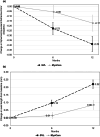Clinical evaluation of MyoCare in Europe (CEME) for myopia management: One-year results
- PMID: 40296784
- PMCID: PMC12087851
- DOI: 10.1111/opo.13517
Clinical evaluation of MyoCare in Europe (CEME) for myopia management: One-year results
Abstract
Aims: To evaluate the efficacy of CARE spectacle lenses in slowing myopia progression among European children.
Methods: In a 2-year randomised, parallel-group, double-masked, multicentre clinical trial, 234 European children aged 6-13 years were enrolled. All participants were myopic, with a cycloplegic spherical equivalent refractive error (SE) between -0.75 D and -5.00 D, astigmatism ≤1.50 D, anisometropia ≤1.00 D and myopia progression of at least 0.50 D in the previous year. The treatment group received MyoCare spectacle lenses with cylinder annular refractive elements (CARE), the control group single-vision lenses (SVL). Axial length (AL) and SE were measured at baseline, 6 and 12 months. Wearability questionnaires were administered at 1 week and 3 months. Central and peripheral visual acuity (VA) was recorded at dispensing and after 3 months. Generalised linear models estimated changes in SE and AL, adjusting for lens type, age and baseline measurements.
Results: After 12 months, children wearing CARE lenses showed less myopia progression, with a difference in SE and AL progression (compared to SVL) of -0.21 D (CI: 0.10 to 0.32 D) and 0.14 mm (CI: -0.17 to -0.10 mm), respectively. Central VA did not decrease with CARE lenses. Peripheral VA decreased by 0.10 and 0.09 logMAR in the nasal and temporal zones, respectively. Analysis of fast progressors indicated that 39.7% of SVL wearing eyes progressed by ≤-0.50 D/year compared to 21.1% with CARE (p < 0.01). For AL, 56.0% of SVL children had an elongation ≥0.20 mm compared to 21.3% with CARE (p < 0.01).
Conclusions: In European children, myopia progression was significantly slower with CARE lenses compared with SVL after 1 year of lens wear. Further monitoring will provide a comprehensive evaluation of long-term efficacy.
Keywords: Europe; children; myopia control; ophthalmic lens.
© 2025 The Author(s). Ophthalmic and Physiological Optics published by John Wiley & Sons Ltd on behalf of College of Optometrists.
Conflict of interest statement
Padmaja Sankaridurg is an employee of Carl Zeiss Vision International GmbH and is an inventor on patents and patent applications assigned to Brien Holden Vision Institute and ZEISS Vision Care; Nicole Liu is an employee of Carl Zeiss Vision International GmbH; Arne Ohlendorf is an employee of Carl Zeiss Vision International GmbH; Wayne Li is an employee of ZEISS Vision Care Guangzhou; Cristina Alvarez is a member of the Zeiss Myopia Advisory Board. No conflicts of interest exist for the remaining authors.
Figures



Similar articles
-
The real-world effectiveness of defocus incorporated multiple segments and highly aspherical lenslets on myopia control: a longitudinal study from the French myopia cohort.BMJ Open Ophthalmol. 2025 Jun 26;10(1):e002142. doi: 10.1136/bmjophth-2025-002142. BMJ Open Ophthalmol. 2025. PMID: 40578905 Free PMC article.
-
Comparing Myopia Control Effects of Three Different Orthokeratology Lenses and Spectacle Lenses With Highly Aspherical Lenslets in Low Myopia Children.Transl Vis Sci Technol. 2025 Jun 2;14(6):27. doi: 10.1167/tvst.14.6.27. Transl Vis Sci Technol. 2025. PMID: 40521976 Free PMC article.
-
Efficacy of a progressive multifocal soft contact lens in myopia management in Caucasian children: A two-year follow-up.J Optom. 2025 Jul-Sep;18(3):100567. doi: 10.1016/j.optom.2025.100567. Epub 2025 Jul 5. J Optom. 2025. PMID: 40618703 Free PMC article.
-
Interventions for myopia control in children: a living systematic review and network meta-analysis.Cochrane Database Syst Rev. 2023 Feb 16;2(2):CD014758. doi: 10.1002/14651858.CD014758.pub2. Cochrane Database Syst Rev. 2023. Update in: Cochrane Database Syst Rev. 2025 Feb 13;2:CD014758. doi: 10.1002/14651858.CD014758.pub3. PMID: 36809645 Free PMC article. Updated.
-
Efficacy of spectacle lenses specifically designed for myopia control: systematic review and meta-analysis.Graefes Arch Clin Exp Ophthalmol. 2025 Apr;263(4):909-924. doi: 10.1007/s00417-024-06706-4. Epub 2024 Dec 9. Graefes Arch Clin Exp Ophthalmol. 2025. PMID: 39652182
References
-
- Holden B, Wilson D, Jong M, Sankaridurg P, Fricke TR, Smith EL III, et al. Myopia: a growing global problem with sight‐threatening complications. Community Eye Health. 2015;28:35. Accessed January 15, 2025. https://pmc.ncbi.nlm.nih.gov/articles/PMC4675264/pdf/jceh_28_90_035.pdf - PMC - PubMed
-
- Shah R, Vlasak N, Evans BJW. High myopia: reviews of myopia control strategies and myopia complications. Ophthalmic Physiol Opt. 2024;44:1248–1260. - PubMed
-
- Li X, Huang Y, Yin Z, Liu C, Zhang S, Yang A, et al. Myopia control efficacy of spectacle lenses with aspherical Lenslets: results of a 3‐year follow‐up study. Am J Ophthalmol. 2023;253:160–168. - PubMed
Publication types
MeSH terms
Grants and funding
LinkOut - more resources
Full Text Sources
Medical

